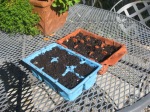How to plant a meadow in California foothills
I do dream of that! In late summer, my new project was to find California native seeds in a large enough quantity at an affordable price, get rid of the weeds and get my meadow. A couple posts back are photos and a description of the beginnings.
Today, I lightly raked the remnants of the sprayed dead filaree sprouts (I’m afraid at the expense of my healing back injury) and sowed the seed.
Here is what I did:
- Made sure most all the weed sprouts were dead and gone.
- Raked the area lightly across the slope.
- Sprinkled the pure seed by hand on a windless morning.
- Sprinkled half one direction and half the other across the area.
- Stepped on the seed as I went and again after watering lightly.
Since no rain is expected, I will lightly water my future meadow each day for a week or so. Also, seeds were planted in two ponypaks so to easily identify the seedlings.
As I stepped on every square inch of ground, to achieve good soil contact for the seed, I was thinking of a garden sign I found once,
“Who plants a seed, beneath the sod, and waits to see, believes in God.”
Now my personal God, I will leave out of the picture, but I do consider God and Nature one. I must have faith that this will work, and will post here the progress.
Next day note: Contrary to the weather report, it has rained overnight, an ideal situation!
—I believe in God, only I spell it Nature. FL Wright—
A word about S&S seeds
I ordered the seed by phone on a Monday and received it on Thursday. Not bad service. I had bought and planted Western wildflower seed mix from wildseedfarms.com, 4 and 5 years before, but this time I especially wanted native California seed and S&S Seeds had the most reasonable bulk price.
California Native Wildflower Mix $30. per pound includes:
- Achillea millefolium (White Yarrow)
- Clarkia amoena semi-dwarf (Farewell-to-Spring)
- Collinsia heterophylla (Chinese Houses)
- Eschscholzia californica (California Poppy)
- Gilia capitata (Globe Gilia)
- Gilia tricolor (Bird’s Eye)
- Layia platyglossa (Tidy Tips)
- Linum lewisi (Blue Flax)
- Lupinus densiflorus Ed Gedling (Golden Lupine)
- Lupinus succulentus (Arroyo Lupine)
- Mimulus aurantiacus punieceus (Mission Red Monkeyflower)
- Nemophila maculate (Five Spot)
- Nemophila menziesii (Baby Blue Eyes)
- Phacelia campanularia (California Bluebells)
California Flowering Meadow Mix $42. per pound includes:
- Achillea millefolium (White Yarrow)
- Chrysanthemum leucanthemum Ox-Eye (Ox-eye Daisy)
- Clarkia amoena (Farewell to Spring)
- Coreopsis lanceolata (Lance-leaf Coreopsis)
- Eschscholzia californica (California Poppy)
- Hordeum californicum (California Barley)
- Layia platyglossa (Tidytips)
- Linum lewisi (Blue Flax)
- Lupinus bicolor (Miniature Lupine)
- Lupinus succulentus (Arroyo Lupine)
- Melica californica (California Melic)
- Nassella pulchra (Purple Needlegrass)
- Vulpia microstachys (Small Fescue)
S&S Seeds, Inc. Seed Store
Carpinteria, CA
UPDATE: S&S has raised its prices to $48.00 and $54.00 per pound and require a $250. minimum which I begged them to waive, in Fall 2014, and they did.
How to sow wildflower seeds article by Judith Larner
Wildflower FAQ by Wildseed Farms
To find native seeds and plants in your state see the
North American Native Plant Society Home
***
The California Native Meadow project, month by month
What am I really doing in the garden in October? Planning and removing weeds
Do you dream of a natural and beautiful wildflower meadow? Finding and sowing seeding
Let’s check for progress on the meadow! Weeding and watching the weather
How to weed a meadow in the Sierra Foothills More weeding…letting the sprouts thrive
Let’s check on Fall and Winter projects! Identifying seedlings
The wildflower meadow in May Small triumphs
My California native meadow in June Starting to bloom
The midsummer meadow The peak bloom
Stomping down the Autumn meadow Neatening up
Native California meadow in the second year





Pingback: Working quietly along with quail | Sierra Foothill Garden